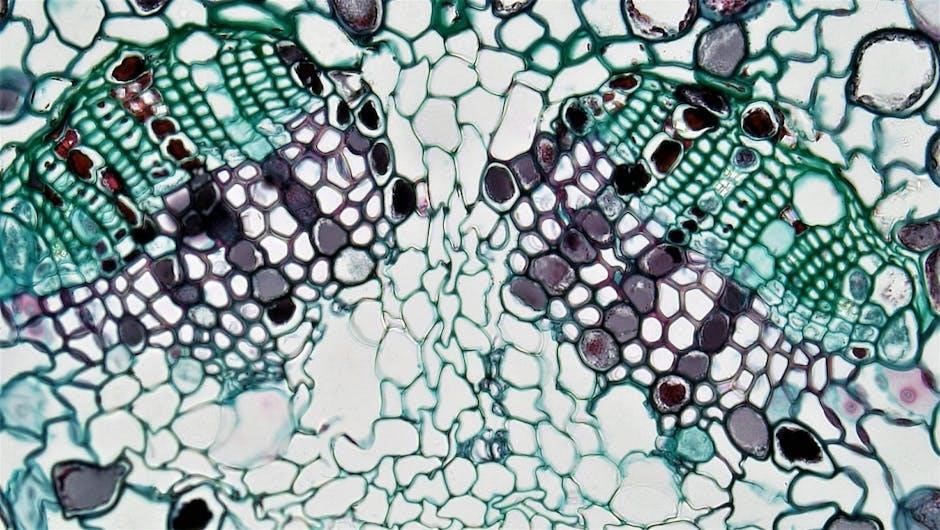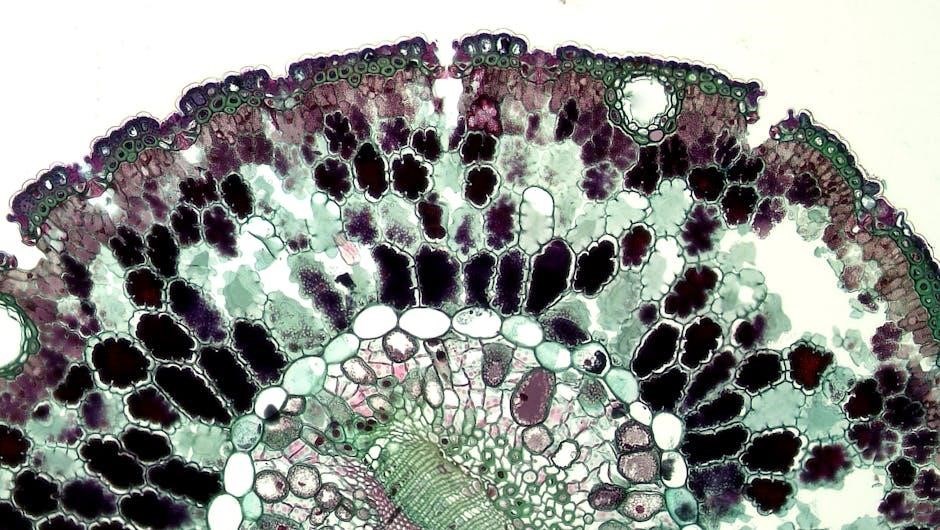Learning about cell structure and function starts with basic concepts and terminology‚ using resources like worksheets and online materials to understand cellular components.
Overview of Cell Types
There are two main types of cells‚ prokaryotic and eukaryotic‚ each with distinct characteristics and functions.
Prokaryotic cells lack a nucleus and other membrane-bound organelles‚ while eukaryotic cells have a nucleus and various organelles that perform specific functions.
Understanding the differences between these cell types is crucial for learning about cell structure and function‚ and can be achieved through the use of worksheets and online resources.
These resources provide a comprehensive overview of cell types‚ allowing students to gain a deeper understanding of cellular biology and its applications.
By studying cell types‚ students can develop a strong foundation in cellular biology‚ which is essential for understanding more complex biological concepts.
Cell Components and Functions
Cell components include organelles‚ membranes‚ and cytoplasm‚ each performing specific functions to maintain cellular homeostasis and overall cell health naturally.
Organelles and Their Roles
Organelles are specialized structures within cells‚ each performing unique functions to maintain cellular homeostasis. The nucleus manages genetic material‚ while the mitochondria produce energy for the cell. The endoplasmic reticulum and Golgi apparatus are involved in protein synthesis and transport. The lysosomes digest and recycle cellular waste‚ and the ribosomes synthesize proteins. The cytoskeleton provides structural support and shape to the cell. Other organelles‚ such as the chloroplasts in plant cells‚ have specific functions like photosynthesis. Understanding the roles of these organelles is crucial for comprehending cellular function and overall cell health. Cells rely on the coordinated efforts of these organelles to function properly and maintain homeostasis.

Cell Shape and Movement
Cells have various shapes and sizes‚ influencing their movement and function greatly always.
Importance of Cell Shape
The shape of a cell is crucial for its function and movement‚ with different shapes allowing for various activities and interactions with the environment.
The cell shape also influences the surface area to volume ratio‚ affecting the rate of diffusion and exchange of materials.
Cells with unique shapes‚ such as nerve cells‚ have specialized functions and are able to perform specific tasks due to their structure.
The importance of cell shape is evident in the way it enables cells to adapt to their environment and interact with other cells and molecules.
Understanding the importance of cell shape is essential for understanding cellular function and behavior‚ and is a key concept in cell biology and related fields‚ including medicine and research.
Cell shape is a fundamental aspect of cellular structure and function‚ and its importance cannot be overstated.

Cellular Structure and Function Worksheets
Worksheets provide interactive learning tools for understanding cellular structure and function concepts clearly.
Available Resources
Various online resources‚ including worksheets and educational websites‚ offer comprehensive materials for learning about cell structure and function. These resources provide interactive tools‚ such as diagrams‚ charts‚ and quizzes‚ to help students understand complex cellular concepts. Many websites‚ like CK12‚ offer free downloadable worksheets and lesson plans for teachers and students. Additionally‚ online educational platforms provide access to a wide range of cell structure and function worksheets‚ including PDF files‚ that can be easily downloaded and printed. These resources cater to different learning styles and levels‚ making it easier for students to grasp cellular biology concepts. By utilizing these available resources‚ students can gain a deeper understanding of cell structure and function‚ and develop essential skills in biology and related fields. Overall‚ these resources play a vital role in enhancing the learning experience.

Key Concepts in Cell Structure and Function
Understanding cell transport and homeostasis is crucial for learning cellular biology concepts effectively online.
Understanding Cell Transport and Homeostasis
Cell transport and homeostasis are essential concepts in cellular biology‚ involving the movement of materials across cell membranes and maintaining a stable internal environment; The cell membrane plays a crucial role in regulating what enters and leaves the cell‚ with various transport mechanisms such as diffusion‚ osmosis‚ and active transport. Homeostasis is critical for maintaining proper cellular function‚ and cells use various mechanisms to regulate factors such as pH‚ temperature‚ and nutrient levels. Understanding these concepts is vital for learning about cellular biology and can be achieved through online resources‚ including worksheets and educational materials. These resources provide a comprehensive overview of cell transport and homeostasis‚ allowing students to gain a deeper understanding of these complex processes;

Cell Membrane and Organelles
Cell membrane surrounds and protects the cell‚ regulating movement of materials‚ with organelles performing specific functions;
Functions of the Cell Membrane
The cell membrane is a thin layer that surrounds the cell‚ regulating the movement of materials in and out. It controls what enters and leaves the cell‚ protecting the cell from harmful substances. The cell membrane also helps to maintain the cell’s shape and structure‚ and plays a role in cell signaling and communication. Additionally‚ the cell membrane is semi-permeable‚ allowing certain molecules to pass through while keeping others out. This helps to maintain the cell’s internal environment and regulate the balance of fluids and electrolytes. The cell membrane is a vital component of the cell‚ and its functions are essential for the cell’s survival and proper functioning‚ as outlined in cell structure and function worksheets and online resources.

Leave a Reply